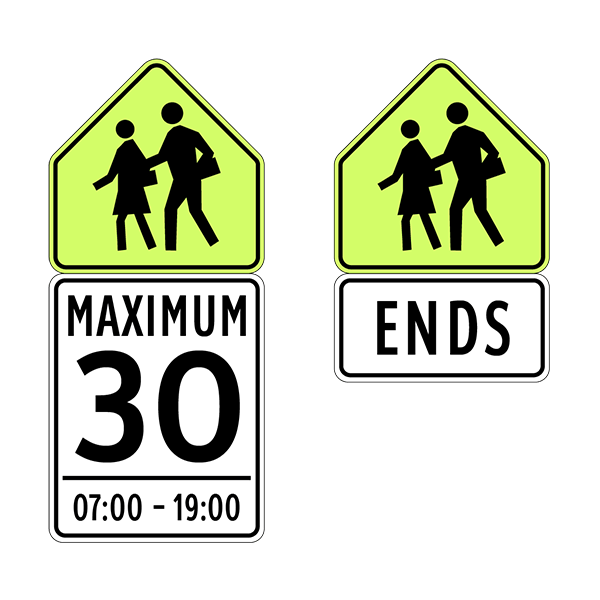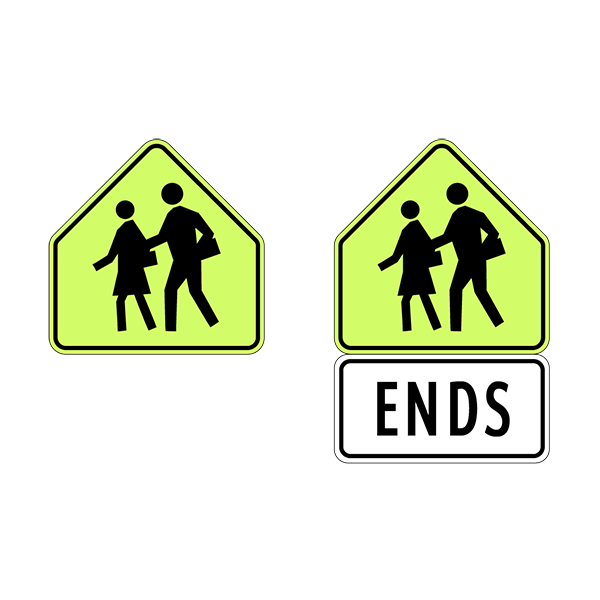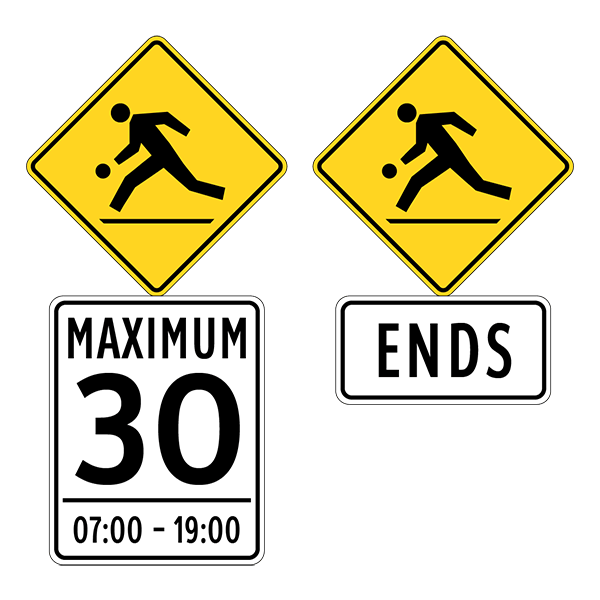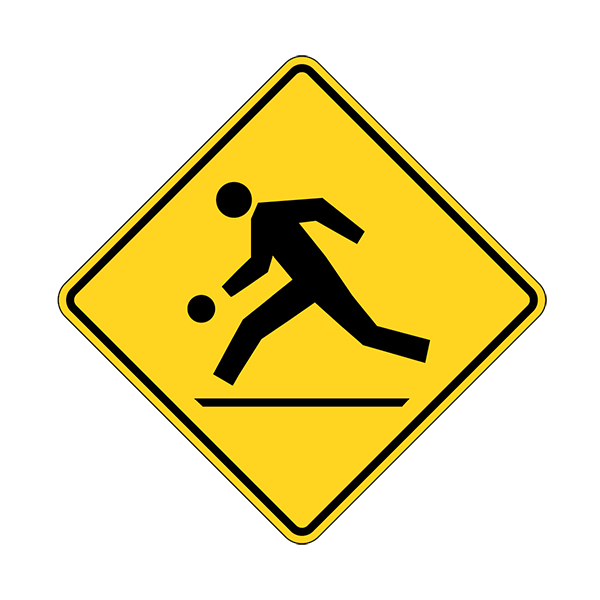School & Playground Zones
Speed limit changes for schools and playgrounds are now in effect
New signs and updates to existing signs have been installed to reflect these changes. Map: zoom into your area to see all school and playground zones.
- New playground zones with reduced speed limits of 30 km/h;
- Year-round reduced speed limits in both school and playground zones 7 days a week from 7 a.m. to 7 p.m.
- Adjustments to posted signs and length of current school zones; and
- Removal of reduced speed from high schools, where u-turns are still restricted.
Getting children to and from school and where they play safely is everyone's responsibility.
- Young children tend to think cars can stop instantly.
- Children believe that if they can see your car, you can see them.
- Children under 10 do not accurately judge vehicle speed or distance.
- Vehicle-pedestrian accidents involving children tend to result in serious injury, even death.
- The penalty for speeding in a school zone is the same as any other speeding offense, resulting in fines and penalized three SGI demerit points.
New Speed Limit Information and Signs
School Zones
|
 |
High Schools and schools with lower risk
|
 |
Playground Zones
|
 |
|
 |
What is the difference between a Zone and an Area?
| Zones (30 km/h sign posted) | Areas (no speed posted) | |
|---|---|---|
| Schools and playgrounds | For children 14 and under | For children older than 14 |
| Reduced speed to 30 km/h | Yes | No |
| Reduced hours in effect | Year-round, 7 days a week, 7 a.m. to 7 p.m. | Not applicable |
| No u-turns | At elementary schools | At high schools |
Driving in a school zone
As a driver, you are responsible for obeying the traffic laws.
What should drivers do in a school zone?
- Slow down
- Be alert
- Obey crossing guards
- Exercise caution near school buses
- Use good judgment when stopping or parking
- Have your child exit the curbside of the vehicle
- Do not drop your child off in the middle of the street
- Treat each child as your own
Walking in a school zone
What should pedestrians do in a school zone?
- Stay on sidewalks and pathways whenever possible.
- Always cross the street at an intersection or designated crosswalk.
- Look both ways before crossing the street. When the road is clear, proceed quickly to minimize your time on the road.
- Do not jaywalk or cross in the middle of the road. Drivers don't expect to see you there.
- Accompany young children when crossing the street.
- Pay attention. Remove headphones and avoid talking on cellphones when crossing the street.
- Allow drivers time to stop before you cross the street. It may take them a moment to notice you and to stop.
School Bus Loading Zones
School bus loading zones are areas of a roadway adjacent to a school designated as passenger loading/unloading zones by signs that set out the limits of the zones. School bus loading zones are in effect from 8:00 a.m. to 5:00 p.m., Monday to Friday. The loading zones must be kept clear for school bus usage. Do not stop or park in school bus loading zones. Enforcement penalties may be levied for non-bus drivers that utilize this space.
Drop-off and Pick-up Zones
Parking in school zones is prohibited in designated areas, which are typically located close to entrances and exits so that children who are entering or leaving the school can see and be seen by other motorists.
Several schools throughout the City have designated drop-off and pick-up zones. This area is to be used for immediate loading or unloading of passengers. Drivers must pull into these areas, never reverse. School staff or parent volunteers will be available to assist your child get into or out of the vehicle and to and from the school.
This area is not intended as a parking area to wait for your child. If your child needs assistance going in and out of a vehicle or needs to be walked into the school, please park in a designated parking area.
Drop-off
- Have your child ready to exit the vehicle when you have pulled up to the curb.
- Come to a complete stop and have your child exit the vehicle on curbside only.
- Drive away from the zone once your child is safely out of the vehicle.
- Do not wait to watch your child enter the school.
- Do not exit your vehicle at any time.
Pick-up
- Your child should be standing at the pick-up zone ready to enter the vehicle.
- Remind your child to stay safely back from the road and to only enter the vehicle from curbside.
- Do not exit your vehicle at any time.
The drop-off and pick-up zone should be kept clear at all times and only used for its intended purpose. Failure to do so can result in frustrated drivers and children who are not exiting or entering curbside are being placed in an unsafe situation.
U-turn Restrictions
U-turns are restricted in school zones through City Bylaw. The fine for violating this restriction is $90 and enforcement is handled by the Saskatoon Police Service.
Why restrict u-turns in school zones?
The best way to keep children safe in a school zone is to maximize visibility, ensuring that each child can see and be seen by drivers in the area.
If a vehicle is performing a u-turn, children who are walking, running and playing in the area may not anticipate the change in direction. Similarly, as you are performing a u-turn your blind spots change and you may not be able to see what is happening behind your vehicle.
Why are School Zone speed limits are changing?
Vehicle speed and pedestrian safety have been the top concerns of residents who participated in 77 Neighbourhood Traffic Reviews in 2013 through to 2021, and many people felt pedestrian and vulnerable people, such as children, were at risk of injury. Following a city-wide speed limit review in 2021, City Council approved changes to extend School Zones to year-round with longer hours and implement playground zones. Learn more about the 2021 Speed Limit Review public engagement process.
How does reducing the speed limit make a difference?
Slowing from 50 km/h to 30 km/h gives the driver more time to react, allows the driver to see more (field of vision) and gives the driver a chance to come to a complete stop faster. Children are more vulnerable to severe injury in a crash than adults, so should a crash occur, it is less likely that it would have severe consequences at a reduced speed.
Where is the collision data to support more reduced speed limits?
A background information report with the collision history details is included in Appendix 1 of this Information Report from June 2021 (PDF). There are collisions in school zones; however, the data has not been aggregated to find the number of collisions in each school zone. During extensive public engagement through city-wide neighbourhood traffic reviews, residents shared examples of collision close calls with pedestrians and vehicles. Slower speeds can prevent the collision from occurring and are shown to reduce the severity of collisions as slower speeds reduce stopping sight distance, promote visibility, increase awareness of potential conflicts, and results in an improved survival rate.

